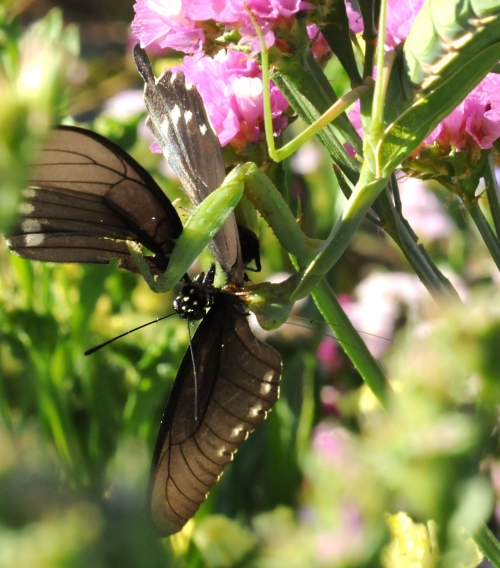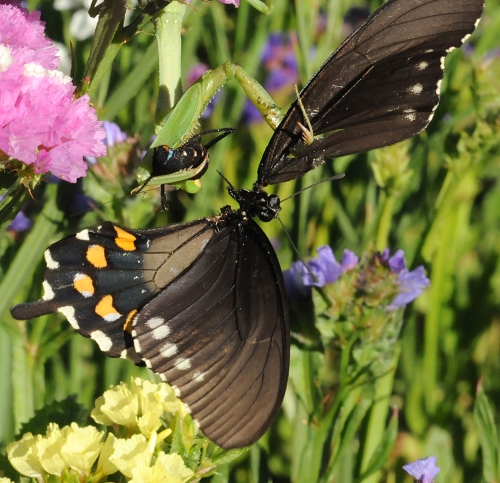- Author: Kathy Keatley Garvey
Hello, Friday Fly Day!
It's time to post an image of syrphid fly, aka hover fly or flower fly.
We took this dorsal view of a syrphid fly in January of 2009.
This syrphid fly, probably as Syrphus opinator, was warming its flight muscles in the Ruth Risdon Storer Garden, part of the 100-acre UC Davis Arboretum and Public Garden. These flies are often mistaken for honey bees.
Interested in flower flies and their biological control roles? You'll want to read entomologist Robert Bugg's piece on "Flower Flies (Syrphidae) and Other Biological Control Agents for Aphids in Vegetable Crops" (Publication 8285, May 2008, University of California, Division of Agriculture and Natural Resources.) Bugg, who holds a doctorate in entomology from UC Davis, and his four co-authors illustrated the 25-page research article with photos that will help you recognize many of the syrphids.
At the time Bugg was a senior analyst, agricutural ecology, UC Sustainable Agriculture Research and Education Program, UC Davis. Perfect name for an entomologist, don't you think?
Happy Friday Fly Day!
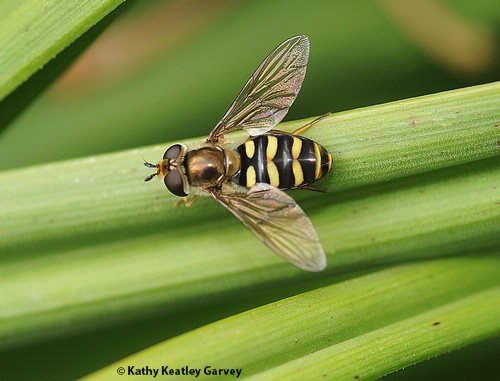
- Author: Kathy Keatley Garvey
The 40 mile-per-hour howling wind didn't seem to bother the syrphid fly, aka hover fly and flower fly.
It clung to a blossom on the tower of jewels, Echium wildpretii, and proceeded to nectar. Its wings sparkled in the morning sun.
This is a pollinator and one that's often mistaken for a honey bee.
A honey bee it isn't. It's a fly.
If you want to read more about them, be sure to check out entomologist Robert Bugg's UC ANR publication, Flower Flies (Syrphidae) and Other Biological Control Agents for Aphids. Click on the link for access to a free 25-page PDF.

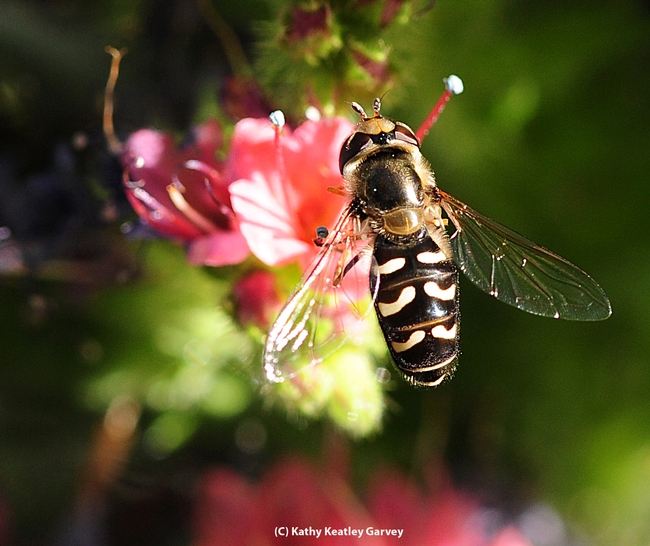
- Author: Kathy Keatley Garvey
Have you seen the little syrphid flies, aka flower flies and hover flies, hovering around the early spring blossoms?
We saw half a dozen of them Monday, Feb. 15 nectaring a white ceanothus at the Marshall Post Office in Marin County. The ceanothus is a shrub from the buckhorn family, Rhamnaceae.
Native pollinator specialist Robbin Thorp, emeritus professor of entomology at the UC Davis Department of Entomology, said these syrphids (below) are probably from the genus Toxomerus. The family is Syrphidae (flower flies).
The larvae of these insects are good to have in your garden--they eat aphids, thrips and small caterpillars. The adults feed on nectar and pollen.
The syrphids fly so fast that you almost need a motor drive to capture them in flight. Plus, they seem especially skittish this time of year. Shadow them with your body or camera and they're gone in a flash.
To learn more about flower flies, a good read is Robert Buggs' 25-page booklet, "Flower Flies (Syrphidae) and Other Biological Control Agents for Aphids in Vegetable Crops," published in May 2008 by the University of California, Division of Agriculture and Natural Resources (UC ANR). You can download it for free by accessing this page.It's illustrated with photos that will help you recognize many of the syrphids.
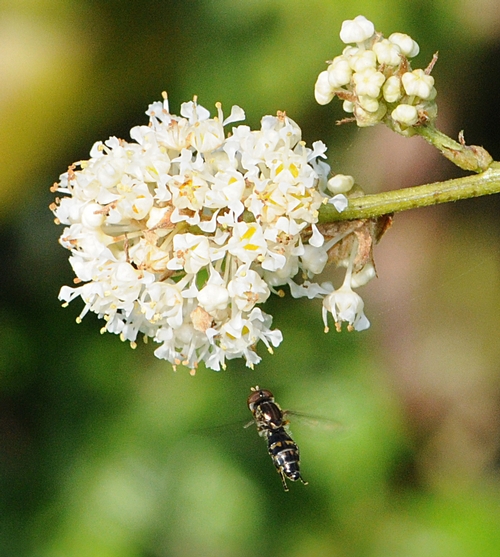

- Author: Kathy Keatley Garvey
It's often mistaken for a honey bee.
It's not a honey bee. It's a hover fly or flower fly.
And this one, hovering around the plants last Saturday in the Storer Gardens at the University of California, Davis, looked like a Syrphus opinator to me.
So I asked UC Davis entomologist Robert "Bob" Bugg, who specializes in flower flies (Syrphidae), what it is.
"If I have to be an opinator, I'd opine that you're right," he quipped.
Bugg, who received his doctorate in entomology at UC Davis, does research on the biological control of insect pests, cover crops, and restoration ecology.
If you want to learn more about flower flies, read Dr. Bugg's "Flower Flies (Syrphidae) and Other Biological Control Agents for Aphids in Vegetable Crops" (Publication 8285, May 2008, University of California, Division of Agriculture and Natural Resources.)
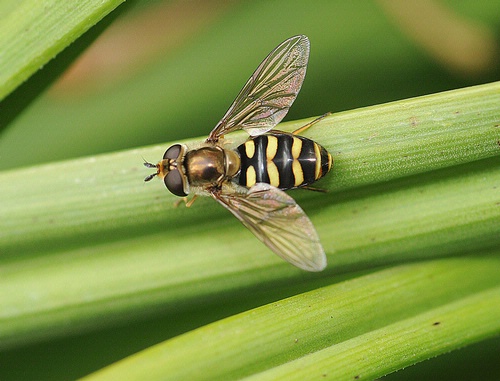
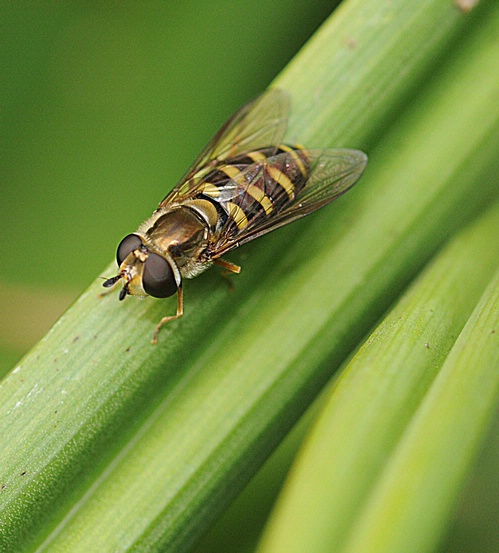
- Author: Kathy Keatley Garvey
Robert Bugg saw it first.
That's entomologist Robert L. Bugg.
Bugg, who received his doctorate in entomology at UC Davis, does research on the biological control of insect pests; cover crops; and restoration ecology.
And he saw it first.
“Look,” he said. “That praying mantis just bit the head off a pipevine swallowtail butterfly.”
We were part of a field tour, “Yolo County Field Tour of Native Bee Habitat on Working Lands.” Held Wednesday, Aug. 27 and organized by the Native Pollinators in Agriculture Project, the field tour drew representatives from the U.S. Department of Agriculture, California Department of Agriculture, California EPA, and farmers from throughout the country.
We visited seven sites: The Farm on Putah Creek, Butler Farm, Good Humus Farm, Cache Creek Conservancy, Muller Farms, Hedegrow Farms, and the Pioneer Hybrid Seed Farm.
I brought along my camera and a macro lens to capture photos of native pollinators, such as long-horned bees, sunflower bees, sweat bees and bumblebees.
We saw the green praying mantis, disguised as a flower stem or blade of grass, at The Farm on Putah Creek.
It had just snared a pipevine swallowtail butterfly (Battus philenor).
It was survival of the fittest, and the matnis was more than fit. Now he was enjoying a morning meal at the expense of a fluttering butterfly.
The praying mantis (sometimes called a "preying matnis") is an ambush predator. It lies in wait for unsuspecting dinner to arrive.
Mr. Mantis grasped the butterfly in his spiked forelegs and chewed off the head.
It was a good day for a praying mantis, a bad day for a butterfly.
